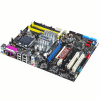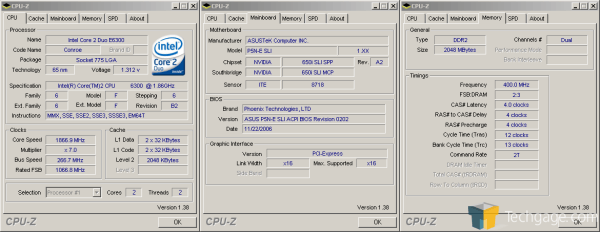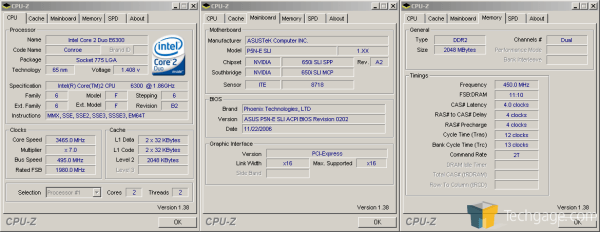- Qualcomm Launches Snapdragon 4 Gen 2 Mobile Platform
- AMD Launches Ryzen PRO 7000 Series Mobile & Desktop Platform
- Intel Launches Sleek Single-Slot Arc Pro A60 Workstation Graphics Card
- NVIDIA Announces Latest Ada Lovelace Additions: GeForce RTX 4060 Ti & RTX 4060
- Maxon Redshift With AMD Radeon GPU Rendering Support Now Available
ASUS P5N-E SLI

When the 680i chipset was launched last month, it proved to have exactly what the enthusiast was after. However, most of those boards range in the $250 area. ASUS has just released their new P5N-E SLI board which offers the 650i chipset. It’s a scaled down version of it’s bigger brother, but costs far less and still contains a huge punch for enthusiasts.
Page 6 – Overclocking
In this section, I will touch on my overclocking experiences with the board. The C2D I have is an E6300, which runs stock at 1.86GHz with a painfully low 7x multiplier. That multiplier by itself takes out a lot of overclocking potential the chip has to offer. To hit 3.5GHz, which is a joke for some of the bigger CPUs, you’d need a staggering 500FSB which is foolish to consider on most boards. Needless to say, I was keen on knowing how well this budget board could handle a huge FSB.
Below you can see the stock CPU-Z report. Nothing in the BIOS really had to be changed in order to have the right clocks, but I did manually set the DDR2 speeds and timings. You may ask why I chose a 2T instead of 1T, and I will tell you in a few moments. The BIOS used on the board is dated for Nov 22, so it’s a full month old. This is no surprise, as about two weeks after this date is when you could purchase the board at retail.
The reason I chose 2T as opposed to 1T for the ram clock is simple… this board is not for ram overclocking. I found this out quickly and even blamed my CPU at first, but it definitely wasn’t the case. The problem is, this board doesn’t seem to want to clock -any- ram beyond DDR2-1000 speeds, regardless of what timings you are running. The folks at AnandTech backed up my findings, by relaying the same issue. However, they seem to have had more success than I did.
In their review, they mention that DDR2-800 speeds at 1T is fine and dandy. I had the opposite experience. DDR2-800 1T would boot fine and be somewhat reliable for Windows use, but as soon as I tried benchmarking, the computer would either halt or reboot. I tried this with two different kits of high-end ram and experienced the same issue. I also tested 1T using both 2.0v and 2.2v, but it made no difference.
Also in their review, they noted that they could use their OCZ Flex ram at DDR2-1066 speeds with 5-6-6 timings. Even though that combination of speed and timings makes me want to cry, I gave it a shot. This was a failure also. I tried to boot with this combination at 2.5vdimm and the PC would not even POST. AnandTech has had better luck than I did, apparently. ASUS is currently in the process of developing a new BIOS to combat this issue, and to me it’s a huge issue.
I look at it this way. All C2D (minus the X6800) has a stock FSB of 1066. On a 1:1 ratio, that would make your ram DDR2-1066 or PC2-8500. This is a common memory speed now, and -should- work since many people like running a 1:1. As the state of the BIOS stands, buying an enthusiast kit of ram would be a complete waste because you cannot overclock it to your liking.
As I mentioned, this is a big issue to me and there is really no excuse for it. I am hoping to see a revised BIOS on the market soon, and will update this section once I have it and can relay my experiences.
Ram rant aside, this is a superb overclocking board otherwise. 86% overclock anyone? Yes, that’s a 3.46GHz speed on a 1.86GHz chip. This speed was benchmark stable, but not Prime95 stable. My absolute 100% stable overclock proved to be 3.33GHz, or a 79% overclock.
The point is not of a huge E6300 overclock though, but the fact that the board handled 495FSB without issue. There are reports around the web from other enthusiasts with this board, who have hit 500 – 515FSB no problem. I believe that would be the max of the board, but that is a huge max! With this type of potential, it means you could “technically” get 4.5GHz out of your E6600, which most likely wouldn’t happen anyway. I think the thing to make clear though, is that it will be the CPU holding back an overclock, not the motherboard.
In the end, I absolutely loved overclocking with this board, but I really hope the ram issue gets sorted out soon. I’ve had my ram at an absolute max of DDR2-990 4-4-4-12-13 with the max chipset voltage, but even a single MHz beyond that point was impossible.
With all of that out of the way, let’s take a look at the performance results and then our conclusion.
|
|
Support our efforts! With ad revenue at an all-time low for written websites, we're relying more than ever on reader support to help us continue putting so much effort into this type of content. You can support us by becoming a Patron, or by using our Amazon shopping affiliate links listed through our articles. Thanks for your support!







